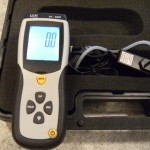 Measuring intake restriction allows you to pinpoint the exact point in your intake system where restriction is occurring and then decide how to best address that restriction. The typical way we deal with restriction in an intake system is just to replace the whole thing with a (usually) expensive intake system.
Measuring intake restriction allows you to pinpoint the exact point in your intake system where restriction is occurring and then decide how to best address that restriction. The typical way we deal with restriction in an intake system is just to replace the whole thing with a (usually) expensive intake system.
However, in many cases, the factory air box could very inexpensively be modified to create the same or better gains than a fancy aftermarket intake. In fact, you'd be surprised to find out that in the real world (ie, not on a dyno but on a real road) that most intake systems do not provide anywhere near the gains they claim. Many in fact, actually hurt your power production - in the real world.
If you ask on a forum which intake is best, you'll get a hundred opinions and people swearing up and down that this intake is better than that one or whatever. However, if you want hard facts from any of them - you'll be met with more e-Facts than anything.
Dyno results are often very deceptive as they are measuring the horsepower output of a car that is strapped to rollers, not moving down the road where aerodynamic forces play a much bigger role than many enthusiasts realize, and with the hood open instead of holding in all that hot air from the radiator and exhaust system. The motivation of the aftermarket part seller is to sell more parts - therefore, they are not always completely honest about their dynos. People on the forums are also not always entirely honest, as many want to believe their car is faster than it is and they've spent money on this intake or exhaust - they want to justify their purchase! No one likes to look foolish.
So what is a wise enthusiast to do? Well, take actual measurements - that's what!
By taking actual, repeatable measurements and taking out all the butt-dyno theory, you can see if the modifications you're doing are ACTUALLY making a difference, or if it's just wishful thinking. You can also see if there's even a need for that shiny aftermarket part, or if the stock part is just fine (or maybe fine with a few minor tweaks!).
How? With a pressure gauge. Differential pressure gauges, pressure gauges, and manometers are all tools that can be used to measure different types of restriction.
For intake systems, we're dealing mostly with mostly negative pressures, or pressures below atmospheric pressure (ie a vacuum). I like to use a digital differential pressure gauge that I picked up for about $130 on eBay some time ago, it has data logging features and is ridiculously simple to use. There are also cheaper options but even at $130 it's a freaking bargain!
You can also use a Dwyer Magnahelic Differential Pressure Gauge (wow that's a long name!) which can be picked up second hand for $20-30 (new they can be kind of expensive), or you can even make your own device known as a manometer for a few bucks of tubing, a coke bottle and some water.
We'll get into how to make your own device or how to use and select a Dwyer gauge in another article. This time I just want to introduce the concept and begin to show you how it's used.
Regardless, the best news is, with this new tool you'll be able to modify intake and exhaust systems on ANY car with near scientific accuracy.
Some Scientific Stuff
Whenever air flows through a pipe there will be a pressure drop across that pipe. In other words, restriction. A differential pressure gauge measures the DIFFERENCE between one side of its input (usually the atmospheric air, the air you're breathing) and the other side (usually for our cases plumed into the intake system).
So, if we want to know how restrictive an intake system is, all we have to do is unplug the PCV vent tube (which is usually the easiest removable vacuum hose nearest the throttle body), and plumb in our gauge. The gauge will measure the restriction from that point to the front of the intake system (usually the intake snorkel or filter).
If you wanted to know how much flow loss you had across a factory air filter, you could plumb one side of your differential pressure gauge to the front, and another side to the back side of the filter inside of the air box, and you'd be able to see how much restriction was being caused specifically by the air filter.
Another thing we could do is plumb the device into the exhaust system by temporarily removing an O2 sensor and measuring the exhaust back pressure in this way. We could then see which parts of the exhaust system were causing restriction and also see the results of any changes we made in a concrete way.
How Restriction is Measured
Atmospheric pressure is 14.7 psi, at sea level on an average day. That's 14.7 pounds per square inch that the air around us is pressing down on, everything.
PSI are often used when we measure boost pressures, so we might say that someone is running 7psi of boost, which basically means that we're cramming half an atmosphere worth of air into the engine over and beyond the 14.7 psi of air pressure that's always surrounding us.
NA vehicles, and turbo cars prior to the compressor, will generally have BELOW atmospheric pressures in their intake systems. This is because the engine is sucking up more air than can fit down the pipe at that moment, creating a small vacuum.
Not even the worst of cars however will generate a much more than a full PSI (1 full psi) of negative pressure. Most will be more on the order of a few tenths of a psi, so we need to use a unit of measure that is more sensitive than PSI. I prefer inches of water (in H2O).
An inch of water is a unit that is exactly what it sounds like - it's the amount of pressure required to move an inch of water up a tube. It turns out that there are 27.7 inches of water to a single PSI.
When measuring an intake system's restriction, you might find that it has a total restriction of 20 inches of water, which would be pretty bad. However, with some simple modifications you might be able to reduce that to as little as 10 or maybe even 5 inches of water.
A pretty good intake system will measure somewhere around 10 inches of water total restriction, whereas an excellent one might be as low as 4 or 5 inches of water, though it is often rare and expensive to get that low.
Don't worry if this confuses you a bit, next time when we start showing you some examples of how to use all of this in a practical way it'll all start to make more sense. It'll also take a while to fully grasp the power of this tool.
Now that we've introduced (very briefly!) the way that we measure intake restriction, we can next time talk about how we actually put all this cool stuff to work to make actual horsepower gains for next to nothing.
I'll also be talking in the weeks to come about measuring exhaust back pressure, aerodynamic pressure, and how we can use all of these measurements to make intelligent modifications to ours cars - and how ultimately, we can get the most BANG for our buck.
Please feel free to leave your questions - I really want to know what you want to know about so I can tailor these articles to YOU.
Until next time...
Extremely Limited Time Offer - 3 Days Only
Get a MASTERS DEGREE in Performance Tuning from the BEST in the Field for ONE low package price
For 3 days only, get ALL of our PREMIUM (not available anywhere else) Tuner University Courses featuring some of the greatest minds in motorsports:
- Top 10 Performance Myths Class (MP3 and Edited Transcript) - $29.95 value
- Performance on a Sip of Fuel Class (MP3 and class manual) - $69.95 value
- Header Design Secrets with John Grudynski (MP3 and transcript) - $69.95 value
- Dirty Secrets of Oil with Ryan Stark (MP3 and transcript) - $69.95 value
- Engine Tuning Secrets with Ben Strader of EFI University (MP3 and Transcript) - $69.95 value
Get all of the above courses (many of which not currently available anywhere else) for one single price of just $309.75 $69.95. A HUGE package savings.
You can also buy any of these individually through our resource center, but I don't know why you would as this is basically the whole store for the price of just 1 course. You'll get the MP3 recordings of each class as well as a transcript or companion manual with each course and you'll be able to download them all INSTANTLY.





